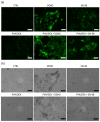Poly(l-lactide- co-caprolactone- co-glycolide)-Based Nanoparticles as Delivery Platform: Effect of the Surfactants on Characteristics and Delivery Efficiency
- PMID: 35564258
- PMCID: PMC9103935
- DOI: 10.3390/nano12091550
Poly(l-lactide- co-caprolactone- co-glycolide)-Based Nanoparticles as Delivery Platform: Effect of the Surfactants on Characteristics and Delivery Efficiency
Abstract
Polymeric nanoparticles made of the copolymer Poly(L-lactide-co-caprolactone-co-glycolide) were prepared using the solvent evaporation method. Two different surfactants, polyvinyl alcohol and dextran, and a mixture of the two were employed. The three types of nanoparticles were used as hosting carriers of two chemotherapeutic drugs, the hydrophilic doxorubicin and the hydrophobic SN-38. The morphostructural characterization showed similar features for the three types of nanoparticles, while the drug encapsulation efficiency indicated that the dextran-based systems are the most effective with both drugs. Cellular studies with breast cancer cells were performed to compare the delivery capability and the cytotoxicity profile of the three nanosystems. The results show that the unloaded nanoparticles are highly biocompatible at the administered concentrations and confirmed that dextran-coated nanoparticles are the most efficient vectors to release the two drugs, exerting cytotoxic activity. PVA, on the other hand, shows limited drug release in vitro, probably due to strong interactions with both drugs. Data also show the release is more efficient for doxorubicin than for SN-38; indeed, the doxorubicin IC50 value for the dextran-coated nanoparticles was about 35% lower than the free drug. This indicates that these nanocarriers are suitable candidates to deliver hydrophilic drugs while needing further modification to host hydrophobic molecules.
Keywords: SN-38; doxorubicin; polymeric nanoparticle; surfactant-drug interaction.
Conflict of interest statement
The authors declare no conflict of interest.
Figures









References
LinkOut - more resources
Full Text Sources
Miscellaneous

